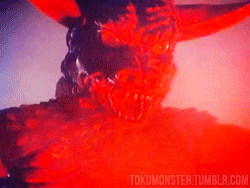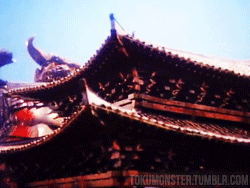In the summer of 2013, I made a list of sixty-plus (primarily) Japanese tokusatsu/daikaiju films for me and my son to watch before the Godzilla movie opens May 16, 2014. Since then, the list has grown by about a dozen. We're still pushing ahead. (The list is HERE.)
Today's film is the North Korean effort Pulgasari (1985).

My son, James, will go first:
Well this one is a mixture of Baragon and Daimajin. The story is that a guy made a model of a god and he gave it to her daughter and her blood made it alive and the monster eats iron. And every few minutes, a person gets "taken" by the bad guys and they bring out Pulgasari. Some of the effects were good but it reminded me too much of Daimajin.
So, rating wise, i'll say 2.16 out of 5 Atomic Breaths of Awesomeness!!!My turn:
The story behind this film is worthy of a film itself.
In 1978, South Korean director Shin Sang-ok and his actress ex-wife were kidnapped by future North Korean dictator Kim Jong-il. Kim, as has been reported and parodied, was a huge cinephile, even going so far as to write a thick book on movies. He put Shin to work making fantasy movies couched with propaganda. One of these is Pulgasari. When it was nearly finished, Shin and his wife (Kim forced them to remarry) managed to escape to a US embassy in Austria while there for a film festival. Another director had to finish the movie.
Kim was a fan of Godzilla films and wanted one for North Korea, and a hero monster, at that. To aid in this movie's creation, Kim imported special effects workers from Japan's Toho Studios, including the Heisei era's man-in-suit himself, Ken Satsuma. (I wonder if Kim tried to hang onto those guys, too?)
I read all of this before we watched the movie and the results of this bizarre backstory surprised me.
I liked it.
The quality of the film (the look of it) feels much older than 1985. This is only helped by the cramped nature of the sets juxtaposed against some rather impressive scenes on location.
In feudal Korea, a tyrannical king rules peasants cruelly and through his various governors. A gang of bandits has organized against the regime and the governor tasks a blacksmith to make weapons for the army using metal from the people's confiscated pots, pans and farming implements. The blacksmith returns the people's items and is found out. Imprisoned without food and near death, the smith's children manage to throw rice into his cell. So near death's door, the blacksmith decides to mold the rice into a small figure of Pulgasari, a Korean legend, and prays for revenge. After the man dies, his daughter has the figure and a drop of her blood brings it to life.
(Let me just say that this smith must have been an amazing artisan, because the Pulgasari figure he made with rice is remarkably detailed.)
The tale of oppression; the ancient mood; the inanimate figure being prayed to, only to later come alive for righteous revenge ... it reminds me of the great Daimajin series. With a few changes, this could easily be a part of it.
I was worried at first as Pulgasari started life as a cutesy thing the size of the rice figurine. But then it began to eat metal and it grew. The goofy music faded away and the rebels took Pulgasari as their figurehead and they marched against the armies of the governor. After each victory, the rebels gave the beast their enemies' swords to eat. Soon it was several stories tall.
There are some pretty cool scenes in this film. One has the bad guys capturing Pulgasari and then setting it ablaze. That only makes the metal eater red hot and angry. When it jumps into a river to cool himself off, it boils the water and kills dozens of bad guys. Another sees the king's ministers creating cannons and rockets to fire at the monster. They are ineffective, of course, but the scenes are entertaining. I've read that the North Korean army was used as extras. Seeing hundreds, if not thousands, of people running into battle certainly helped make the movie feel more epic.
The work of Toho's people is very evident. The suit is very well constructed and look at the poster above. It looks quite a bit like Godzilla. The model work is very good, too:
Look at that. Every tile on that roof is a separate piece and there are even bigger and more elaborate ones than that in the movie. (Some rear projection stuff fails miserably, but it's not used too much.)
If I have a problem with the movie, it's the ending. I won't go into too much detail, but the king has been killed and the people are able to live freely for a change. Unfortunately, they can't keep feeding Pulgasari, so the blacksmith's daughter finds a way to get rid of him. The giant ends up turning into stone and then breaking apart. I don't know if that's how the legend goes or what, but it's weak.
My son and I came up with a better ending: Pulgasari turns back into rice, and since he's so big now, that's enough to feed the starving people for a very long time. Plus, in the middle of the rice would be the iron it ate so they can rebuild their lives. That would work very well.
Here's something else. Kim Jong-il wanted this to be a propaganda film that shows the power of the people. Well, I can see that, but to me, it seems like an effective treatise against the North Norean dictatorship itself. An oppressive regime that wages war on its own citizens and keeps them starving while the leader lives in luxury ... that's North Korea today. Maybe Kim had some cognitive dissonance going on, but it was inescapable to my mind. Of course, the Kims have built up such a mind-numbing cult of personality around themselves, I doubt the people of North Korea would ever be able to make the connection on their own.
Pulgasari ... a fascinating story and good flick, too. 4 out of five atomic breath blasts.Here's the Japanese trailer:
Up next, Godzilla vs. Biollante.
(GIFs by tokumonster)


No comments:
Post a Comment